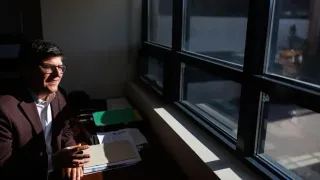September 17, 2023
EuroPride in Malta: Day Two
Kilian Melloy READ TIME: 8 MIN.
Our day officially begins at 11 am, which almost seems too early after the previous night's fun. Breakfast at Mulberries is a hearty selection of hardboiled eggs, yogurt, rolls and cold cuts, and farm cheese made on site; the lingering influence of the British was evident in grilled breakfast sausages and baked beans.
The day's itinerary says nothing about lunch, but after wrapping two hard boiled eggs in a napkin my husband and I feel ready to face the day. Overseeing our group today is Isabelle, a professional tour guide whose encyclopaedic knowledge about everything Malta-related deepens the experience of exploring some of the island's natural and cultural beauty.
Our first stop is a scenic outlook with a vantage of the Blue Grotto, a rock formation on the island's southeast coast that forms vast caverns over teal water that seems luminescent in the daytime sun. But we aren't simply going to observe from afar: Isabelle has a surprise for us in the form of vouchers for the boat service that brings visitors right into the caverns. The boat driver expertly navigates the tiny bark through mildly choppy seas and noses gracefully into one cavern after the next as we make our way toward the huge rock formation we saw from above. The water is limpid and blue – and, we note, filled with large brown jellyfish. (These, we are assured, are harmless, and when two of our group go swimming later on, they report no problems with the creatures.)
The next item on the agenda is Ħaġar Qim ("Hajar Im"), a 3,600-year-old temple built by Malta's first inhabitants, thought to have branched off from the Phoenicians more than 4,000 years ago. Another megalithic temple, Mnajdra, lies fairly nearby; the Mnajdra Archaeological Park has been established at the site, with a visitor center that offers museum exhibitions on the temples and the people who built them, along with a seven-minute 3D documentary on the temples' construction and uses. Fully in the spirit of Pride, as with the rest of the island, the center's gift shop is stocked with rainbow stickers depicting the ancient culture's fertility goddess, rainbow-themed T-shirts, and a catalogue for a Pride-themed show at Valletta's Main Guard museum titled "[Be]loved Malta: Stories of Sexual Gender Identity," which celebrates not only Malta's first EuroPride but the 50th anniversary of the decriminalization of LGBTQ+ people in 1973.
The ruins of Ħaġar Qim are sheltered from wind, sun, and rain by a gigantic tarp that rivals the temple itself. The megalithic temple was constructed from massive blocks of limestone, some weighing as much as twenty tons. The temple testifies to the engineering genius of Malta's earliest inhabitants, who didn't have the wheel, but they did have the inventiveness to fashion spheres of rock, which they used to roll gigantic stone blocks and slabs up hills and across the terrain to the building site. (Some of the blocks still have stone spheres beneath them to this day.)
More history follows with a visit to Malta's first capital city – not Valetta, on the sea, but Mdina, an inland city that, in the modern world, has served as a location for the epic fantasy series "Game of Thrones." The capital was relocated to Valletta centuries ago for military reasons, and today Mdina is a mix of tourist shops, narrow streets plied by horse-and-carriage drivers ferrying tourists on scenic jaunts, church towers, and ancient limestone structures, some of them dating back to the time of the Romans.
The Visit Malta website details that Mdina "was home then, as now, to Malta's noble families; some are descendants of the Norman, Sicilian and Spanish overlords who made Mdina their home from the 12th century onwards. Impressive palaces line its narrow, shady streets.
"Mdina is one of Europe's finest examples of an ancient walled city and extraordinary in its mix of medieval and baroque architecture."
As impressive as the historic sites have been, the day's peak event arrives with a visit to the flagship shop of fashion brand C&R, which stands for Charles & Ron. The two designers are partners in life as well as in business. Charles is a native of Malta; Ron, from Holland, migrated to the island years ago, and has made himself as one with the Maltese, even becoming fluent in their difficult mishmash of a language.
The pair are busy preparing for a show in Milan, where they will debut 30 new looks, on as many models, for Spring and Summer 2024 – "Twenty girls, ten boys," Charles tells us – but they have found time to create some Pride fashions, which are displayed throughout the store: T-shirts, scarves, long skirts, flowing halter tops, and handbags, all reflecting a rainbow motif. Charles and Ron greet our group in person, graciously make time to chat with us. There's more to the story of their first meeting, and Ron recounts it with a laugh. They met, he tells me, at "one of the wildest clubs in Amsterdam. Charles claimed to be a famous fashion designer, telling Ron, "you should come and model for me." That wasn't true... at least, not yet. "As I always say," Ron smiles, "whatever you say is a projection of what's coming." When Ron joined Charles in Malta, they turned that audacious story into reality together, and now C&R has joined the ranks of fashion's major brands.
Isabelle had told us excitedly how Charles and on were the first same-sex couple of be legally married in 2017, but that was also a little adjacent to the truth. "One of the first," Ron says, correcting the record. "Everybody thinks we were one of the first, but it was a little bit after the law was introduced."
In addition to being leading designers, the couple also run a high-end café at their flagship store. They offer us a "snack" that turns out to be a cornucopia of delicacies: Dense, delicious cake (a choice between lemon blueberry or white chocolate), fragrant tea, delicious coffee drinks, healthful "energy balls," and more. How could two people be so good at so many of life's finer things?
Charles demurs to take credit for the delectable food, saying the recipes are not his invention – though, he admits, "I butt in a little" when it comes to the recipes.
Stuffed on our "snack," dinner seems unimaginable; but, come 8:00 pm, our group are present, accounted for, and seated at a long table in the breezy courtyard serving area of MUZA, the Museum of Fine Arts, which also offers fine dining. Another high-profile gay married couple are part of the experience: Donald Tuthill and Robert Adams, the publisher and editor, respectively, of gay travel publication Passport Magazine, join our table and being their wit and humor to the evening, regaling us with tales of Don's early adventures in magazine publishing (he also co-founded a queer magazine in San Francisco), Rob's youthful ambitions to be a filmmaker and stint at film school, and how Passport Magazine is a blend of their talents and passion, down to the cinematic sense of each issue's visual design.
Conversation flows as starters (burrata, this time not deep fried but uniformly soft and smooth, with a flavor similar to buffalo mozzarella; beef carpaccio, served with a truffled got cheese mousse) and entrees (conchiglioni pasta with braised beef, Manchego cheese, and nuts; pan-seared sea bass served with barley and fennel, bisque, and salt-baked tomato; beef tagliata, served in thick slices done to order, with sott'olio vegetables and chimichurri) appear and are savored.
The day's capstone is Eurovision Night, a concert featuring acts made famous by the annual music contest. Austrian drag star Conchita Wurst, the contest's openly gay winner from 2014, is the headliner; the concert, which takes place in Valletta's Piazza Tritoni – a.k.a. "Pride Village" for the duration of EuroPride – a sprawling public square named for the huge, elaborate fountain depicting Triton, the Greek god of the sea. The concert is packed, and includes lighting effects, smoke, and fireworks; the mixed crowd sways, sings, and holds cell phones aloft to capture moments from on stage.
The crowd is the best part of the concert, with groups of gay friends clustered together and singing along, while couples get lost in one another, forgetting the crowd and falling into blissful make out sessions. One cute couple tease each other by plucking hairs off the backs of each other's necks. (You can almost hear them bantering: "Ow!! Quit it!!"). More amusing still are the straight people among us: The heterosexual couples are easy to spot, with the men grasping their wives and girlfriends tightly, almost like men at sea clinging to life preservers. Single men – and the security guys, especially – have no such comfort, and they range through the crowd with stiff, bowlegged gaits that seemed a little extra on the testosterone. At one point my husband leans over to kiss me on the check; as he does so, a man pulling his young son through the crowd by the arm shoots us a hateful scowl. It's the first and only moment of anti-LGTBQ+ animus I encounter while in Malta, which in itself is a testament to the island's generally accepting attitude. As our tour guide Isabelle explained to us, "It's a small island, and we all have friends or family who are gay. If we are to shame gays, then we're shaming our friends' children, and our own. We are a community!"
I smile back at the scowling man. After all, isn't Pride all about showing a little grace, a little compassion, and as much love as we can?






